Reptile & Amphibian
News Blog
Keep up with news and features of interest to the reptile and amphibian community on the kingsnake.com blog. We cover breaking stories from the mainstream and scientific media, user-submitted photos and videos, and feature articles and photos by Jeff Barringer, Richard Bartlett, and other herpetologists and herpetoculturists.
Thursday, October 31 2013
The color of the tiny, endangered Harlequin Mantella, Mantella cowani, makes it a perfect candidate for the alternative name of "Halloween Mantella."
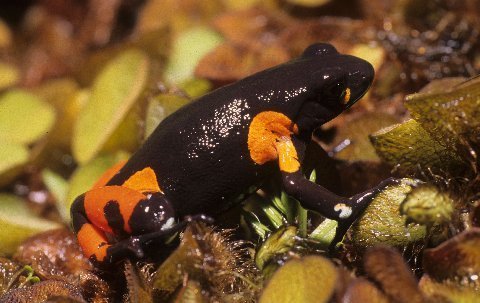
Once sporadically imported for the American (and other) pet trade, it has been several years since it was last available. This frog occurs in high altitude forests and seasonally in wet grasslands in eastern central Madagascar.
As is often the case with localized herp species from areas that are difficult to access, very little is know with certainty about the biology and life history of the inch-long Harlequin Mantella. It is apparently diurnal. The clicking vocalizations of this frog have been heard from shallow stream edges and damp rock crevices. The fewer than 50 eggs are laid in protected damp leaf litter and mosses but the life of the tadpoles remains unknown.
Although no longer legally collected for the pet trade, continuing deforestation and other habitat modifications seemingly remain very real threats to the long-term existence of this remarkably beautiful, Liliputian anuran.
More photos under the jump...
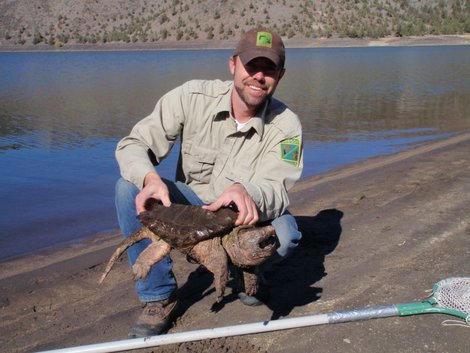 An alligator snapping turtle was found in Oregon reservoir last week.
From KGW.com:
It was the first time the invasive species was found in eastern Oregon, according to Rick Boatner of the Oregon Department of Fish and Wildlife.
The species is native to the southeastern United States, Boatner said. It can grow to 250 lbs.
"I'd hate to see these turtles get established in Oregon," Boatner said. "We already have problems in the Willamette Valley with common snapping turtles."
He added that the alligator snapping turtle can be very aggressive, and it's a safety hazard to people.
"It has quite a bite," he said.
Read the full story here.
Photo: Oregon Dept. of Fish and Wildlife
This image of a Tortoise, uploaded by kingsnake.com user reptileszz, is our herp photo of the day!

Upload your own reptile and amphibian photos photos at gallery.kingsnake.com, and you could see them featured here!
Wednesday, October 30 2013
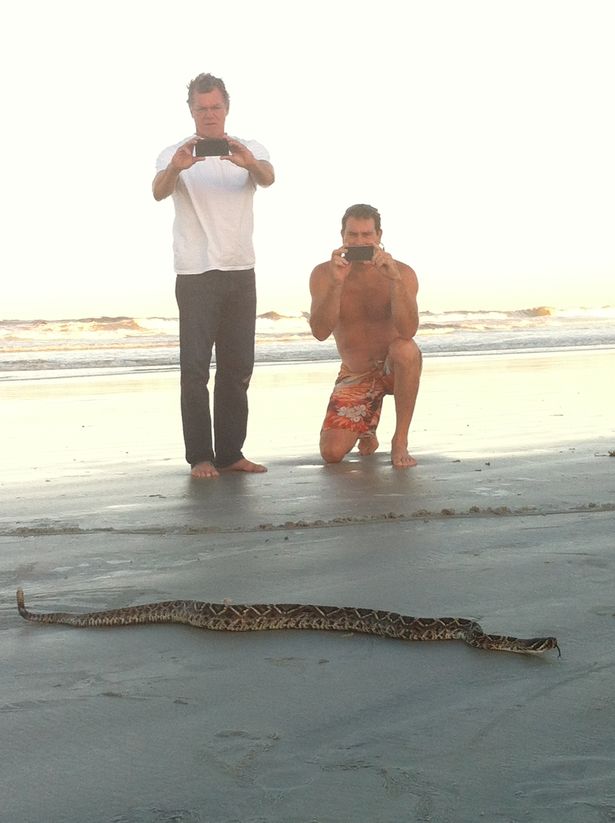 Let's go surfin' now, all the snakes are learnin' how...
Okay, not all the snakes. But some Eastern Diamondback Rattlesnakes have been spotted on a Florida beach and in the ocean recently.
From WFTV.com:
Valeh Levy shot video Friday New Smyrna Beach but said her son was one of the first surfers to spot the snake in the waves.
"My son came running up toward my minivan and he said, 'Mommy, you're not going to believe this but there's a rattlesnake in the surf,'" Levy said.
Witnesses estimate it was 4-5 feet long and came onto the beach from the ocean. Levy said her son described how surfers tried to avoid the snake swimming right by them.
"He said the coolest part was that the snake raised half of its body up and looked out towards the surf and a wave was coming and the snake turned towards the beach and kind of let the wave bump it on in," Levy said.
Experts said it isn't common to see a rattlesnake in the ocean, but Smyrna Dunes Park near where the one was spotted is a natural habitat for them where they eat rats, small rabbits, and even baby raccoons.
Read the rest here!
Photo: WFTV
This image of a Tree Frog, uploaded by kingsnake.com user bradtort, is our herp photo of the day!

Upload your own reptile and amphibian photos photos at gallery.kingsnake.com, and you could see them featured here!
Tuesday, October 29 2013
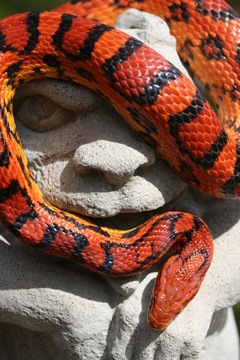 Why are so many humans afraid of snakes? Scientists may have the answer.
From the LA Times:
We’re not born with a fear of snakes, but it sure seems to develop early.
Now scientists may be closer to a explaining why ophidiophobia ranks among the top fears of humans, and seems to be shared with other primates.
Researchers inserted probes into the brains of Japanese macacques and found that neurons in a part of their brain that controls visual attention were more strongly and quickly activated in response to images of snakes, versus other objects.
The results, published online Monday in the journal Proceedings of the National Academy of Sciences, appear to support a theory that early primates developed advanced perception as an evolutionary response to being prey, not as an adaptation that may have made foraging or hunting easier.
Read the full story here.
Photo: kingsnake.com user cochran
I grew up only a few houses away from a fair-sized lake in Massachusetts where I spent a lot of time as a kid watching musk and painted turtles in the shallows and American and Fowler’s toads when they gathered on the sandy shores in the spring to trill or scream, and listening to the plunking notes of green frogs and the jug-o-rums of Bullfrogs, Rana catesbeiana.
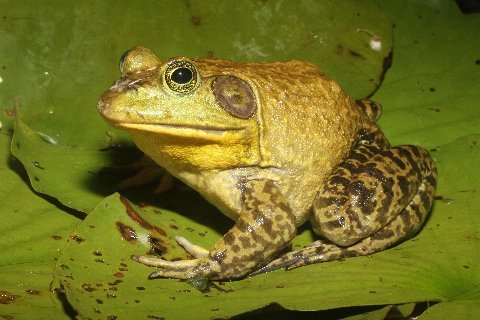
Jug-o-rum? I listened to the squeaky fright notes of first-year bullfrogs along the lakeshore and to the deep bass of the old territory-holders out in the lily-pad patches, but I’m not sure I ever heard one of those bullfrogs say jug-o-rum.
I read Conant. I read Behler and King. They both mentioned the jug-o-rum calls. So I began listening to bullfrogs in earnest. I listened to the bullfrogs on Longmeadow Flats. Heard a lot of deep notes, but jug-o-rum? Nope. Ditto for the ones in northern New Jersey, for all in southeastern South Carolina, and for others in north Florida.
"Brrrrrrrrrrummmmmm," or maybe "urrrrrrrrr-ummmmmmm," but no matter where the chorus was heard -- Maine, Texas, or Baja California -- I heard nary a jug-o-rum amongst them. Not a one!
So one hot summer night, seeking validation for my inability to hear what seemed to be the traditional call, I talked Jake Scott into a bullfrog search and listen foray in north central Florida. We found a spot that was literally resounding with bullfrog vocalizations. I listened and, happily, didn’t hear a single jug-o-rum. Ok, Jake, I asked, what do the bullfrogs say? His answer was immediate: "Jug-o-RUMMMMMMM."
I give up. Jug-o-rummmmmm it is.
More photos under the jump...
This image of a Black Pine Snake, uploaded by kingsnake.com user pitparade, is our herp photo of the day!

Upload your own reptile and amphibian photos photos at gallery.kingsnake.com, and you could see them featured here!
Monday, October 28 2013
Check out this video "Bearded Dragon eating," submitted by kingsnake.com user captainjwl.
Submit your own reptile & amphibian videos at http://www.kingsnake.com/video/ and you could see them featured here or check out all the videos submitted by other users!
This image of a Rainbow Boa, uploaded by kingsnake.com user sonjakoolmo, is our herp photo of the day!

Upload your own reptile and amphibian photos photos at gallery.kingsnake.com, and you could see them featured here!
Friday, October 25 2013
People broke the law, but it's the alligator who died.
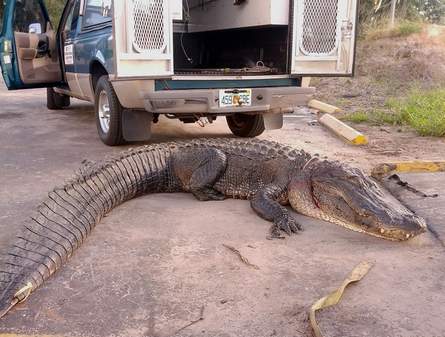 Because Florida law prohibits relocating alligators larger than 4 feet in length, this healthy, 11-and-a-half foot animal was killed after some idiot tethered him to a tree behind an apartment complex.
From the Tampa Tribune:
That alligator gator stretched 11 feet, 6 inches and may have hatched when Richard Nixon was president, said Phil Walters, the licensed trapper called out Wednesday afternoon to corral and kill the beast behind the Rivertree Landing Apartments off Sligh Avenue, east of 56th Street.
The back of the complex borders a scenic stretch of the Hillsborough River just south of Temple Terrace.
“We had heard that a couple of people had caught and tied the gator to a tree,” Walters said.
That was indeed the case. A stretch of parachute cord stretched from a tree over a 4-foot seawall and into the river, where the gator floated at the other end of the line.
Walters said some residents told law enforcement that unidentified people “had caught it and was feeding it cats,” keeping it as a backyard pet of sorts.
Whether the cat diet rumor is true or not, Walters was unsure. He does note that it’s a bad idea to feed an alligator anything because the free food makes the reptiles lose their fear of humans and associate people on the shore with getting a snack.
Read the full story here.
Photo: Phil Walters/Tampa Tribune
This image of a Salamander, uploaded by kingsnake.com user travisdimler, is our herp photo of the day!

Upload your own reptile and amphibian photos photos at gallery.kingsnake.com, and you could see them featured here!
Thursday, October 24 2013
 Under ordinary conditions I like birds of prey. But the red-shouldered hawks in this neighborhood have about outstayed their welcome, at least from me. The hawks moved in, built a nest in a big pine a few houses away, and set up serious housekeeping. First it seemed to be the introduced Cuban Brown Anoles that were the preferred prey. Although I enjoy watching the anoles they really don’t belong here and there seems no way the hawks could get them all anyway.
A few years ago, Patti and I decided that the Southern Toads needed a helping hand to make it through what seemed to be a never ending drought. We put a little 10 x 12 foot pond up on the hill and toad song again filled the neighborhood. And Southern Leopard Frogs moved in. The toads were pretty nocturnal but the leopard frogs were active both day and night. The hawks soon found these. New prey.
But then the Eastern Garter Snakes and Southern Black Racers also found the frogs in our puddle. The snakes moved in and their populations persisted for about three years. It was nice to see a big racer periscoping for frogs.
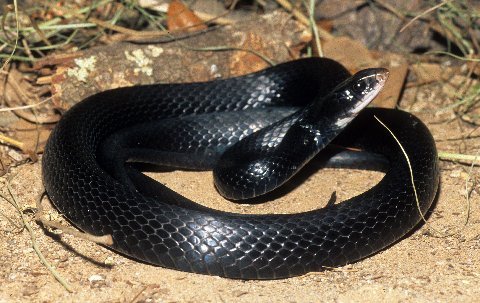
Continue reading "Racers: Going... going... temporarily gone"
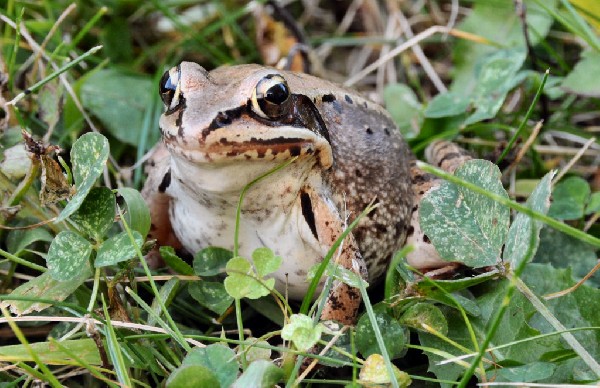 On Monday, we reported on an immune system characteristic that leaves amphibians particularly susceptible to the chytrid fungus, which is responsible for massive declines in amphibians populations around the world. Now, it looks like the herbicide atrazine is also increasing the susceptibility of frogs to chytridiomycosis.
From Phys.org:
USF Biologist Jason Rohr said the new findings show that early-life exposure to atrazine increases frog mortality but only when the frogs were challenged with a chytrid fungus, a pathogen implicated in worldwide amphibian declines. The research is published in the new edition of Proceedings of the Royal Society B.
"Understanding how stressors cause enduring health effects is important because these stressors might then be avoided or mitigated during formative developmental stages to prevent lasting increases in disease susceptibility," Rohr said.
Read the full story here.
Photo: kingsnake.com user galen
This image of a Galapagos Tortoise hatchlings, uploaded by kingsnake.com user jerry d. fife, is our herp photo of the day!

Upload your own reptile and amphibian photos photos at gallery.kingsnake.com, and you could see them featured here!
Wednesday, October 23 2013
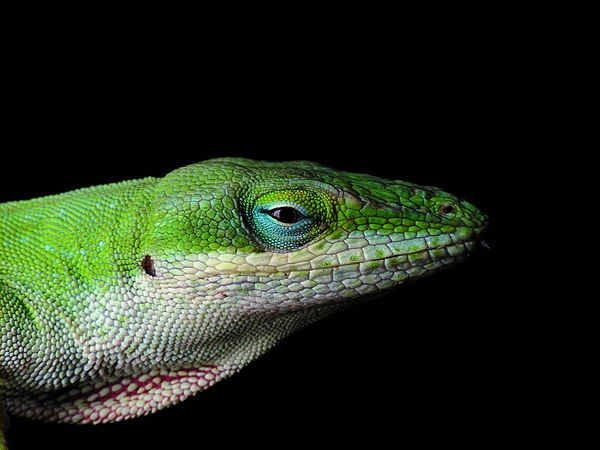 A thriving population of green anoles is living in a Los Angeles neighborhood.
From KCET.org:
The lizards that biologists just found thriving in the Hancock Park neighborhood of Los Angeles aren't a new species: they're the extremely well-studied green anole. But as the Los Angeles County Natural History Museum's Lila Higgins reports, the discovery marks the first confirmed established population of the common reptile in Los Angeles County, and scientists are curious as to what effect the little lizards may be having on native wildlife.
Green anoles are native to the southeastern U.S. and nearby islands, where --- ironically they're in trouble due to competition from exotic reptiles. Hancock Park isn't the first beachhead green anoles have made in the state: a population has been established in San Diego's Balboa Park for many years, and reptile watchers also report a thriving colony of the sleek lizards in and around Temecula. Individual green anoles have been documented in places like Northridge and Chino Hills.
And according to Higgins, Hancock Park neighbors have told Natural History Museum herpetologist Greg Pauly that the anoles have been there as long as they can remember.
Read the full story here.
Photo: PiccoloNamek/Wikimedia Commons/Creative Commons License
Our screened back deck is a wonderful addition to the house. Rather than a deck we refer to it as our aviary, for it is home to a half a dozen European goldfinches that entertain us non-stop. But we could just as well call it our "lizardarium," for despite deterring the omnipresent mosquitoes many local lizards wander in and out along pathways known only to them.
Broad-headed skinks appear now and again, but most of the lizards are one of two kinds of anoles, the native green or the introduced Cuban brown. The green anoles are the most active and the most arboreal, and as I watch their antics my thoughts often drift back to the first green anoles I ever saw.
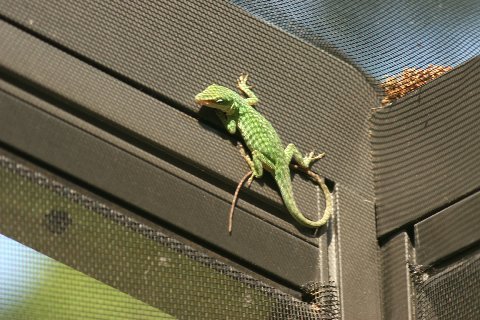
It was in the 1940s, I was 7 or 8 years old, and the anoles, a slender golden chain affixed around their neck (no photos), were being offered for sale as living lapel decorations at the New York Sportsman’s Show.
They were being sold as American chameleons, and with them came a care sheet that explained that all the purchaser needed to do to assure the lizard a long life was to provide it with sugar water.
I had never seen such wonderful creature and sugar water would be easy enough to provide, so I wheedled my parents into buying me one lizard. Through trial and error I learned that the little lizard needed a much more varied diet than sugar water and that when he was turned loose on my mother’s houseplants he avidly hunted houseflies and other insect repast.
Could this little lizard have been the cause of my lifelong infatuation with herps? Well, it and the long ago herp supply company, Quivira Specialties, certainly were contributors to my lingering interest.
More photos under the jump...
This image of a Giant Mexican Musk Turtle, uploaded by kingsnake.com user Katrina, is our herp photo of the day!

Upload your own reptile and amphibian photos photos at gallery.kingsnake.com, and you could see them featured here!
Tuesday, October 22 2013
 Scientists are honing in on the immune factor that is allowing amphibian populations to succumb to the fungal disease chytridiomycosis, which has caused a loss of nearly 4 percent of amphibian populations every year between 2002 and 2011.
From Popular Science:
It's been most baffling, given the amphibians' complex immune systems, not far off from the immune complexity of humans and other mammals.
"There's been a big question in terms of why the amphibian immune system hasn't been able to respond to this nasty skin infection," Louise Smith-Rollins, an associate professor of pathology, microbiology and immunology at Vanderbilt, tells Popular Science. "The question is, if it's a failure to recognize the pathogen, what's the defect?"
Rollins-Smith has been studying this immune response for more than 10 years, and she and her team have found another clue as to why amphibians can't clear this fungus. This week in Science, a paper she co-authored brings in new information to understanding the answer to that question. The study, led by Vanderbilt graduate students J. Scott Fites and Jeremy Ramsey, shows that it may be the second line of immune defense where the breakdown occurs.
The first line of defense, antimicrobial peptides produced in the skin, seemed to be effective at producing an immune response. But during the next stage, something happened to stop the usual inhibiting response.
"It appears that the defect is that the fungus itself is able to release factors that target vulnerable lymphocytes and induce them to commit suicide," Rollins-Smith says. "Mediators that should be regulating and calling in the troops, they're stopped right there."
Read the rest of the story here.
Photo: Joel Sartore/Popular Science
This image of a Rhacodactylus Gecko, uploaded by kingsnake.com user mrusso, is our herp photo of the day!

Upload your own reptile and amphibian photos photos at gallery.kingsnake.com, and you could see them featured here!
Monday, October 21 2013
This image of a Milksnake, uploaded by kingsnake.com user sballard, is our herp photo of the day!

Upload your own reptile and amphibian photos photos at gallery.kingsnake.com, and you could see them featured here!
Check out this video "Ball Python Clutch, Day 41," submitted by kingsnake.com user kcalderala.
Submit your own reptile & amphibian videos at http://www.kingsnake.com/video/ and you could see them featured here or check out all the videos submitted by other users!
Friday, October 18 2013
Scientists working to protect loggerhead sea turtles know how to save them; they just can't get stakeholders to cooperate.
From Mission Blue:
It's been our experience that those who would spend two decades or more working closely with fishermen to understand and protect sea turtles typically have the best interests of both people and nature in mind, although sometimes they are called "turtle-huggers" or scapegoated over another competing agenda.
Back in the early 1990’s when we learned about the mass mortality of loggerhead sea turtles off the Pacific coast of Baja from geographers Serge Dedina and Emily Young, we responded immediately.
Here’s how Dr. Dedina describes what they found:
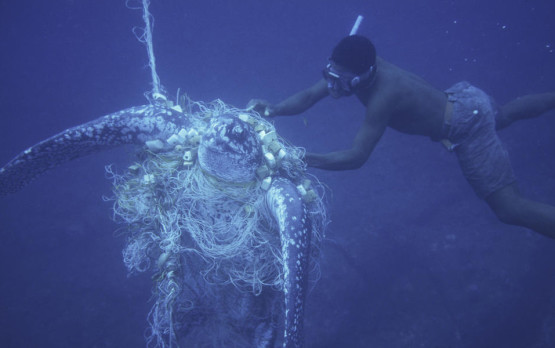
"We first started noticing the mortality of loggerheads on Magdalena Island on the trip out to Cabo San Lazaro in the Spring of 1994 when we noticed a few animals stranded on the beach. But as summer progressed we saw more and more. What was fascinating was to see the correlation between stranded loggerheads and the abundant coyote population who fed on the animals as they washed up. There were literally dozens of coyotes sitting in the dunes apparently satiated after a night of feeding.
By July 1994, on one return trip from San Lazaro, we counted more than 224 dead loggerheads, so many, that the fishermen we were with were clearly embarrassed. They all knew that the turtles were being caught in gill-nets. In fact we had been out shark fishing with fishermen in the spring and had seen the problem ourselves."
Read the full story here.
Photo: Mission Blue
This image of a Carpet Python, uploaded by kingsnake.com user chuckn16, is our herp photo of the day!

Upload your own reptile and amphibian photos photos at gallery.kingsnake.com, and you could see them featured here!
Thursday, October 17 2013
The car was far ahead of us when it swerved sharply. What, we wondered, was the reason for that?
Jake and I were road cruising and not in any real hurry. The car ahead had disappeared from sight around a curve, and we were now near their position when they had swerved.
Suddenly Jake yelled, "Canebrake!" And sure enough, lying almost dead center in the road was a 4-and-a-half foot long canebrake rattler, Crotalus horridus "atricaudatus."
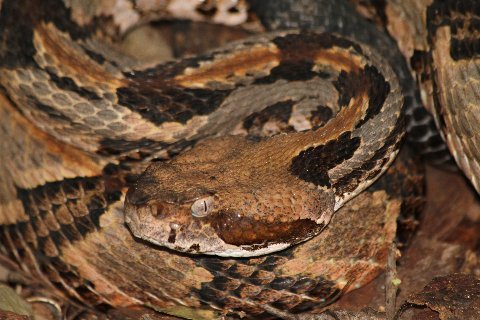
As I slowed to a stop, Jake grabbed a hook and piled out. As he neared the snake, now alerted, another car approached from around the curve. Jake touched the snake on the tail and fortunately, the snake proved to be a runner. It wanted no familiarity with anything and darted across the road, but then stopped on the grassy verge and looked like it was heading back. We stopped it.
The other car, filled with young women, stopped near us. They asked in unison, "What is it?"
"Rattler," Jake replied.
"What are you doing with it?" one of them asked.
"Keeping it off of the road." I replied.
"Let it go," one of the young women said. "We came back to kill it."
"Looks like you’re out of luck," I told them.
"You’re not killing this one," Jeff said. A couple of more unintelligible comments, and they left.
Gives me a warm, fuzzy, feeling to know that Jake and I were able to save this big male from the road idiots.
The locale was rather open, and once the canebrake was in the canebrake, having slowed to cross the roadside ditch, we guided him to the foot of a big pine.
Once against it, he coiled quietly, a monarch of the southern brakes.
More photos under the jump...
 Every year kingsnake.com gets asked, "I want to hold a contest and give away a live animal, can I advertise this on your site?"
The answer is surprising to many: kingsnake.com and our other pet-related sites will not accept advertising for live animal contests.
No, it's not because we don't like contests.
Aside from the ethical problems raised by giving away live animals to people who may not, or cannot, care for them responsibly, many states have outlawed the practice, or limited the practice but regulate it in some manner. Some allow it with certain animals, and in certain circumstances, while others outlaw it completely.
Many of these laws have been on the books for decades, some having been written in response to specific problems. Often they were implemented in response to traveling carnivals that would offer goldfish, green iguanas, anolis lizards, turtles, or even baby alligators as inexpensive prizes in games of chance on the midway. Who hasn't seen goldfish bowls at the carnival?
Most, if not all, of these animals died horrible deaths at the hands of owners ill-equipped to deal with them, many times unsupervised children, and over the years many states took action to make the practice illegal or to limit what could and couldn't be offered as a prize.
Does your state have laws against animal giveaways? If so, you may be subject to criminal charges, either as the contest holder or the contest winner. What makes it even more dangerous and problematic is when the contests -- and prizes -- cross state lines. When that happens, a simple misdemeanor, can easily turn into a federal crime.
When a live animal contest crosses state lines, and the contest violates either the state laws of the contest holder or the prize winner, then according to the United States Fish & Wildlife Service, a violation of the federal Lacey Act statutes has occurred, regardless of the species involved. Thus a leopard gecko or ball python that may be 100 percent legal to purchase, keep, possess, and ship across state lines, is illegal as a contest prize instead of a purchase.
So, should you participate in live animal giveaway contests?
If you're a responsible pet owner with experience in the species offered as a prize, and the contest does not violate your state or local laws, or the contest holder's state laws, then there is nothing wrong with participating in a live animal giveaway. But do your homework first! Or that next "prize" might be more than you bargained for.
This image of a Tiger Snake, uploaded by kingsnake.com user MVH4, is our herp photo of the day!

Upload your own reptile and amphibian photos photos at gallery.kingsnake.com, and you could see them featured here!
Wednesday, October 16 2013
The sea turtles are here!
Every year in early fall, hundreds of olive ridley sea turtles hit the beaches on Mexico's Pacific coast to lay their eggs.
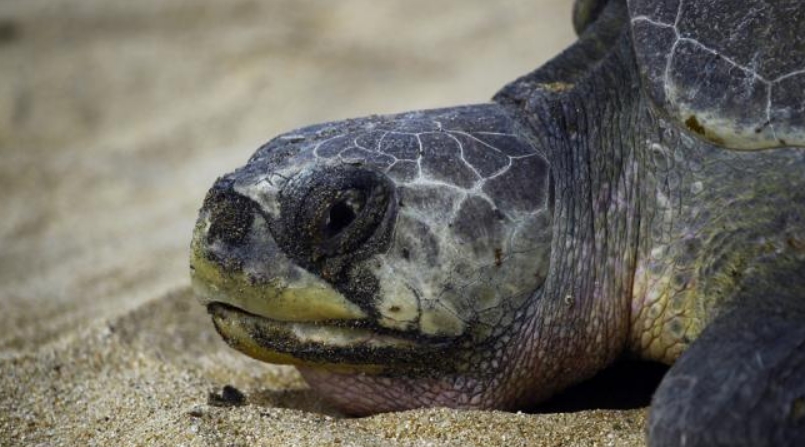
Read all about it, and see the complete photo gallery, here.
Photo: Weather.com
This image of a Rosy Boa, uploaded by kingsnake.com user Rust, is our herp photo of the day!

Upload your own reptile and amphibian photos photos at gallery.kingsnake.com, and you could see them featured here!
Tuesday, October 15 2013
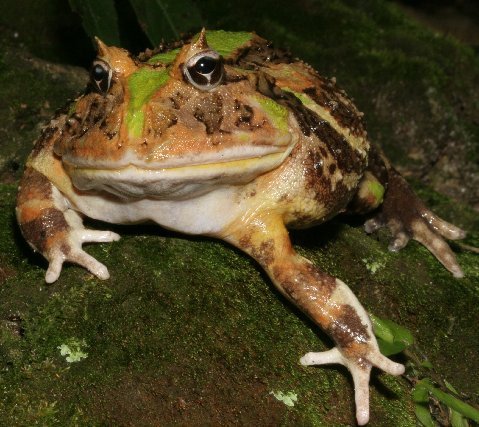 The last time Patti and I visited the Daytona Captive Breeders Expo was four years ago. I had looked at about all of the ball pythons and leopard geckos I chose to see on that day, and we were taking the long way around to the exit.
As I was passing almost the last sales booth in that aisle, I glanced to the left and stopped in my tracks. In one of the half dozen tanks on the table was a beautiful lizard that I recognized immediately as a Diploglossus lessonae. I sidled over to the table, and as I got there my interest in the lizards was sidetracked by a tank of frogs.
They were a Pacman-type frog but of a species I had not before seen. The vendor asserted that they were Brazilian horned frogs, Ceratophrys aurita. Based on that, I purchased the only one of the three that looked in good condition. This was a male and even he had what appeared to be a corneal lipid deposit on one eye. We named him Grumpy. Philippe deVosjoli bought the other two, and I believe that they are still alive. Philippe determined that the species was not aurita as initially thought, but was another Brazilian taxon, Ceratophrys joazeirensis, a mid-sized species.
Whatever this little frog may be, he has now stared at me morosely for the better part of four years. His periods of quietude are interspersed with an occasional night of vocalizing as thunderstorms or tropical depressions roll through. And he has never once refused his nightcrawlers. Not once.
More photos under the jump...
Continue reading "Life with Grumpy: Four years and counting"
|



